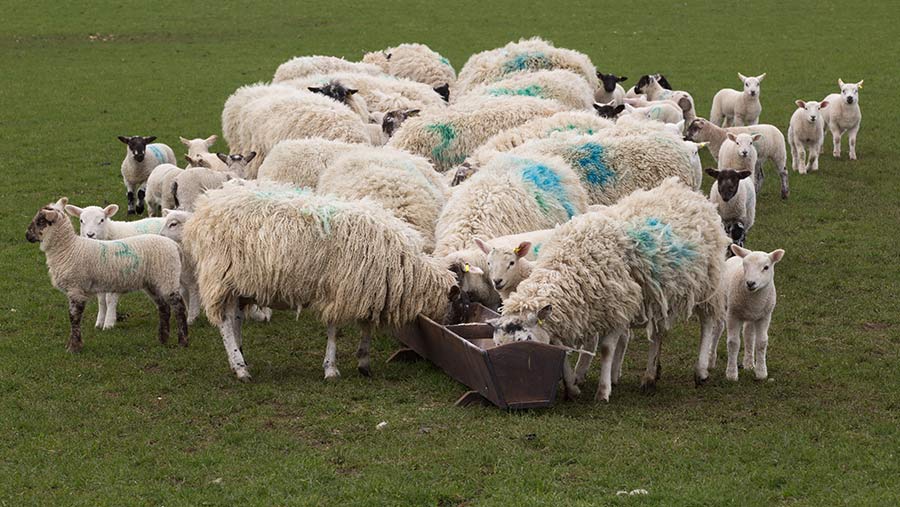6 tips on dealing with poor spring grass growth
 © Tim Scrivener
© Tim Scrivener Grazing deficits are being reported in all UK regions as persistent cold temperatures challenge growing conditions.
Overnight temperatures in some regions fell as low as -5.5C in mid-April, according to the Met Office.
Low minimum temperatures had been “notable’’ for early April, it says, with some stations breaking their local record for the lowest minimum temperature recorded for April. These areas including Carlisle, Fair Isle and Betws-y-Coed, where temperatures ranged from -4.1C to -5.5C.
But even regions that haven’t experienced those freezing conditions have grass growth checks, says grazing consultant James Daniel.
“Most farms are in a feed-deficit situation. Although it is dry, moisture is not the limiting factor right now, it is the cold that is holding back growth,” he explains.
See also: How to get the best from red clover in grassland
The growth check comes at a time of the year when land is not available to graze on some farms due to reseeding on winter forage crop areas. Meanwhile, demand is at its highest with cows and ewes approaching peak lactation.
According to GrassCheckGB, growth this week remains below normal, averaging just 24.4kg of dry matter (DM)/ha/day, compared with the two-year average of 38.1 kg.
Below, Mr Daniel advises how farmers can best manage this early-season feed gap.
1. Measure average farm covers
Quantify how much grass is available on-farm – a sward stick is the cheapest option if you don’t already have a plate meter.
If you know many kg DM/ha of grass is available it makes it easier to budget.
Take two measurements one week apart.
Alternatively, use the Grasscheck GB or, in Wales, the Farming Connect Pasture Project websites as reference points. These have current and accurate average growth rates for your region.
2. Work out total daily feed demand
Once you have the supply and demand figures, you can work out the balance and how many days grazing that will provide.
For instance, a lactating cow needs roughly 18kg DM/day so if you are running two cows a ha, demand will be 36kg DM/ha/day.
If you measure and growth is 30kg DM, the deficit is 6kg DM. If you don’t measure, after 10 days you will have 60kg DM/ha less on the farm until eventually you run out of grass.
Daily feed demand per head for other classes of stock:
- Lactating cow: 16-18kg DM/day
- Growing cattle: 10kg DM/day
- Weaned calves: 6kg DM/day
- Ewe with lambs: 3kg DM/day
- Dry ewes: 1.5kg DM/day
- Weaned lambs: 1.1kg DM/day
3. Prioritise which stock to allocate grass
When grass supply is short, give the highest priority to lactating animals, otherwise the performance of suckling lambs and calves will be compromised, and it will be costly to catch up at a later stage.
Don’t run dry cows with the milking herd – remove these from the grazing platform and feed baled silage.
Use body condition as a guide for decision-making. If animals lose body condition it can affect pregnancy rates later in the year.
4. Consider bringing silage ground into the grazing rotation
Reduce your demand by allowing stock to graze silage fields – on most sheep and beef farms land has yet to be locked up for silage, so there is an option to include this.
If calculations show at least 30 days of available grazing ahead, it should not be necessary to bring the silage ground into the rotation, but if you have less than 30 days, graze some of the silage ground. The grass might be quite long, but it will buy you more grazing.
If slow-growing conditions persist, you might be forced to feed silage shortly after conserving it, so it makes sense to graze some now and cut the rest.
Sheep are not ideally suited to grazing tall grass, in particular when they are suckling lambs. If sheep are the only livestock on the farm it is better to cut the silage to get the land back into the rotation and offer other supplementary feed.
5. Use feed demand to work out what supplementary feeding is needed
It is better to be proactive and feed early to enable animals to reach peak lactation.
There is little availability of fodder beet this year, so that leaves concentrate as an energy and protein source for lactating ewes. In the short term, you might have to spend £5,000 on feed, but the payback in performance will be worth four times that amount later in the year.
Use silage to fill the feed gap for other classes of livestock. A round bale of silage contains approximately 240kg DM and each bale will feed the following number of animals for one day:
- Lactating suckler cows: 12-14
- Growing cattle: 24
- Weaned calves: 40
- Dry ewes: 160.
6. Revise fertiliser plans
Revise your fertiliser application plans because nitrogen needs moisture to allow uptake by the plant.
Urea requires moisture to convert into ammonium nitrate and, without rain, it can’t do that. A minimum of 20mm of rain is needed within 20 hours of application or losses to the atmosphere can be up to 60%.
Ammonium nitrate or protected urea are better alternatives in dry periods but think about what the plant needs – it might need higher soil temperatures or rain, not nitrogen.
Small applications are more effective. Flexibility is needed, because rigidly sticking to existing policies in a dry period will cause swards to use less than you apply.
